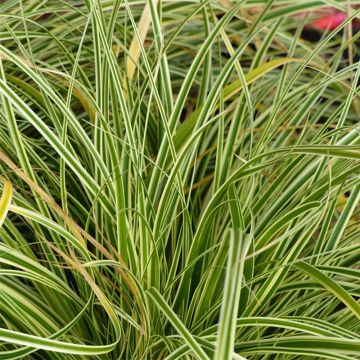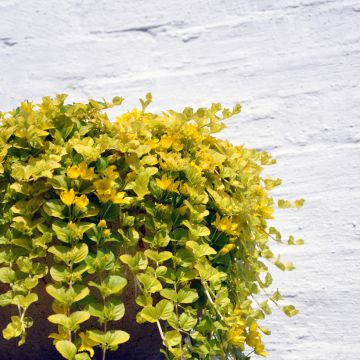

Carex acuta - Acute Sedge


Carex acuta - Acute Sedge
Carex acuta - Acute Sedge
Carex acuta
Acute Sedge, Slender Tufted-Sedge, Slim Sedge
This item cannot be shipped to the selected country
Delivery charge from €5.90
More information
Schedule delivery date,
and select date in basket
This plant carries a 12 months recovery warranty
More information
We guarantee the quality of our plants for a full growing cycle, and will replace at our expense any plant that fails to recover under normal climatic and planting conditions.
From €5.90 for pickup delivery and €6.90 for home delivery
Express home delivery from €8.90.
Does this plant fit my garden?
Set up your Plantfit profile →
Description
The Carex acuta, also known as the Sharp-Edged Sedge, a plant related to grasses, is found along the water's edge in our marshes, throughout France, and especially in the central and northeastern regions. This medium to large-sized perennial forms a clump of evergreen, very fine, bluish-green leaves and produces beautiful cylindrical spikes of dark brown flowers, between May and August. This carex is planted on the edge of a water point for its qualities as a bank stabilising plant. It can also be used for its purifying qualities in a phytoremediation pond. It requires no maintenance.
The Carex acuta belongs to the Cyperaceae family. Native to Eurasia, it is found almost everywhere in the world. This rhizomatous plant, similar in appearance to grasses, with running rhizomes, forms an upright and arching clump, reaching a height of 50 to 80 cm and a diameter of about 40 cm, spreading over time to form large colonies in moist or waterlogged soils. This species grows at a depth ranging from 0 to -5 cm of water. Its leaves, evergreen in winter, sheath-like at the base, are long, slender (4 to 8 mm wide), linear, with tapered edges, slightly trailing. They have a bluish-green colour. The older leaves dry out in winter to make way for new leaves in spring. In spring, in April-May depending on the climate, floral stems appear bearing male or female spikes. The male spikes, thick, cylindrical-elliptical, dark brown, barely emerge from the foliage and are quite decorative. As with all Carex species, it is monoecious, producing separate male and female flowers on the same individual.
The Carex acuta can be planted in any type of wet area, in full sun or partial shade. Useful for maintaining banks or for its purifying qualities, it can also be planted for its ornamental value on the edge of a pond. In the company of other bank plants, equally decorative, such as Acorus, Cirsium rivulare or purple plume thistle, Butomus umbellatus or flowering rush, Alisma parviflora, or even Caltha palustris.
Report an error about the product description
Flowering
Foliage
Plant habit
Botanical data
Carex
acuta
Cyperaceae
Acute Sedge, Slender Tufted-Sedge, Slim Sedge
Western Europe
Other Carex
Planting and care
The Carex acuta is an easy-to-grow plant in full sun, in any moist garden soil, even clayey and heavy soil. It is capable of covering areas where it thrives. Water abundantly at planting, which should be done outside of frost periods. Avoid excessive fertiliser application. Remove damaged foliage during growth, but never prune the clump completely in late winter. If you want to prevent self-seeding, trim the faded flowers.
In phyto-purification, it is planted with a density of 8 plants per m2.
Planting period
Intended location
Care
This item has not been reviewed yet - be the first to leave a review about it.
Ground cover perennials
Haven't found what you were looking for?
Hardiness is the lowest winter temperature a plant can endure without suffering serious damage or even dying. However, hardiness is affected by location (a sheltered area, such as a patio), protection (winter cover) and soil type (hardiness is improved by well-drained soil).

Photo Sharing Terms & Conditions
In order to encourage gardeners to interact and share their experiences, Promesse de fleurs offers various media enabling content to be uploaded onto its Site - in particular via the ‘Photo sharing’ module.
The User agrees to refrain from:
- Posting any content that is illegal, prejudicial, insulting, racist, inciteful to hatred, revisionist, contrary to public decency, that infringes on privacy or on the privacy rights of third parties, in particular the publicity rights of persons and goods, intellectual property rights, or the right to privacy.
- Submitting content on behalf of a third party;
- Impersonate the identity of a third party and/or publish any personal information about a third party;
In general, the User undertakes to refrain from any unethical behaviour.
All Content (in particular text, comments, files, images, photos, videos, creative works, etc.), which may be subject to property or intellectual property rights, image or other private rights, shall remain the property of the User, subject to the limited rights granted by the terms of the licence granted by Promesse de fleurs as stated below. Users are at liberty to publish or not to publish such Content on the Site, notably via the ‘Photo Sharing’ facility, and accept that this Content shall be made public and freely accessible, notably on the Internet.
Users further acknowledge, undertake to have ,and guarantee that they hold all necessary rights and permissions to publish such material on the Site, in particular with regard to the legislation in force pertaining to any privacy, property, intellectual property, image, or contractual rights, or rights of any other nature. By publishing such Content on the Site, Users acknowledge accepting full liability as publishers of the Content within the meaning of the law, and grant Promesse de fleurs, free of charge, an inclusive, worldwide licence for the said Content for the entire duration of its publication, including all reproduction, representation, up/downloading, displaying, performing, transmission, and storage rights.
Users also grant permission for their name to be linked to the Content and accept that this link may not always be made available.
By engaging in posting material, Users consent to their Content becoming automatically accessible on the Internet, in particular on other sites and/or blogs and/or web pages of the Promesse de fleurs site, including in particular social pages and the Promesse de fleurs catalogue.
Users may secure the removal of entrusted content free of charge by issuing a simple request via our contact form.
The flowering period indicated on our website applies to countries and regions located in USDA zone 8 (France, the United Kingdom, Ireland, the Netherlands, etc.)
It will vary according to where you live:
- In zones 9 to 10 (Italy, Spain, Greece, etc.), flowering will occur about 2 to 4 weeks earlier.
- In zones 6 to 7 (Germany, Poland, Slovenia, and lower mountainous regions), flowering will be delayed by 2 to 3 weeks.
- In zone 5 (Central Europe, Scandinavia), blooming will be delayed by 3 to 5 weeks.
In temperate climates, pruning of spring-flowering shrubs (forsythia, spireas, etc.) should be done just after flowering.
Pruning of summer-flowering shrubs (Indian Lilac, Perovskia, etc.) can be done in winter or spring.
In cold regions as well as with frost-sensitive plants, avoid pruning too early when severe frosts may still occur.
The planting period indicated on our website applies to countries and regions located in USDA zone 8 (France, United Kingdom, Ireland, Netherlands).
It will vary according to where you live:
- In Mediterranean zones (Marseille, Madrid, Milan, etc.), autumn and winter are the best planting periods.
- In continental zones (Strasbourg, Munich, Vienna, etc.), delay planting by 2 to 3 weeks in spring and bring it forward by 2 to 4 weeks in autumn.
- In mountainous regions (the Alps, Pyrenees, Carpathians, etc.), it is best to plant in late spring (May-June) or late summer (August-September).
The harvesting period indicated on our website applies to countries and regions in USDA zone 8 (France, England, Ireland, the Netherlands).
In colder areas (Scandinavia, Poland, Austria...) fruit and vegetable harvests are likely to be delayed by 3-4 weeks.
In warmer areas (Italy, Spain, Greece, etc.), harvesting will probably take place earlier, depending on weather conditions.
The sowing periods indicated on our website apply to countries and regions within USDA Zone 8 (France, UK, Ireland, Netherlands).
In colder areas (Scandinavia, Poland, Austria...), delay any outdoor sowing by 3-4 weeks, or sow under glass.
In warmer climes (Italy, Spain, Greece, etc.), bring outdoor sowing forward by a few weeks.






















































